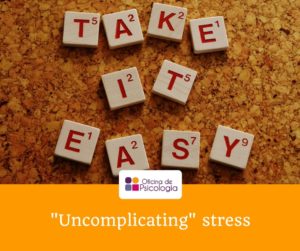 First things first: To master how to ease stress we have to understand it.
First things first: To master how to ease stress we have to understand it.
Stress can be explained as any adaptation required to a person. It is a physical and mental imbalance caused by internal or external factors, such as violence, change of habits, technology and perfectionism for instance. If this imbalance is restored fast, there is no major damage to the organism. Otherwise, bad things can happen.
This way of understanding stress is to think of it as a neutral agent, capable of becoming positive or negative according to the perception and interpretation of each person. The positive and beneficial stress is called eustress. It motivates and stimulates us to deal with a certain situation, maintaining our concentration levels and engagement in order to achieve a goal. In contrast, distress is the stress which holds us from dealing with a situation, making us experience feelings like frustration and withdrawal. Burnout is the most aggravated form of distress. It is a special type of occupational stress characterized by a deep sense of frustration and exhaustion in relation to the work performed. A feeling that can gradually extend to all areas of a person’s life.
So how do you think we can reduce the stress in our daily lives?
Everyone says “you have to relax …”. But why relax?
Well, if we imagine our brain as a muscle we can understand that it is not possible to keep using it to exhaustion and still expect it to work properly without any sign of reduced performance. We have to let it rest and relax once in a while to re-energize it. Relaxing helps us feel good, focused and live a peaceful life. It also gives us the opportunity to best think about our problems, make decisions in a more conscious and clear way.
Alright then…so how do we relax?
Well, I guess you might not like the answer I am about to give you, as you will think it won’t work. But please, hold those judgmental thoughts for a moment and give it a try.
The answer is… breathe!
It may seem a simple answer, but it is actually quite complex. Do you know how to breathe properly? Do you pay attention to your breathing pattern throughout the day? Do you know if you breathe in a slow, fast or average pace?
Please take one minute to do a simple test: count how many breathing cycles (air coming in and then out) you do.
How did you go?
I can tell you that, on average, an adult has 15 breathing cycles in a minute. Above this figure, you may benefit from learning some breathing techniques.
Although breathing is the first thing we do when we are born, setting in motion the lungs we spent several months forming in our mum’s womb, it is likely that some of us spend a lifetime without using them to their full potential. Some of us might be breathing to survive, but not to live to our full potential!
Breathing releases endorphins. What is it? It is a neurotransmitter of “pleasure”, which regulates emotions and the perception of pain, helping us to relax and to generate a feeling of well-being. Endorphin is considered a natural pain reliever, reducing stress and anxiety. Therefore, a slow, deep, and rhythmic breathing pattern produces a calm and peaceful state of mind, helps us to unlock emotions, regulate negative thoughts and to have an overall sense of well-being.
Given our stress-fueled days, learning the art of breathing well becomes of the utmost importance. For that, there are some simple tools that can be applied in several occasions at any time. Below are just a few examples:
- Diaphragmatic breathing
- Muscle contraction / relaxation
- Visualization
- Mindfulness
Are you keen on adding these tools to your toolbox? Talk to us then!




